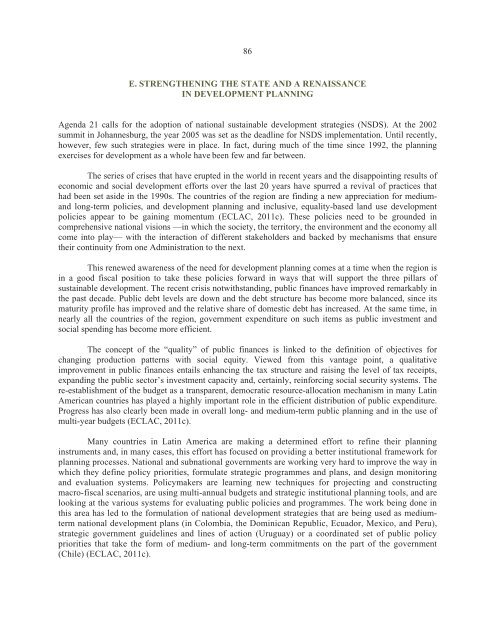sustainable development 20 years on from the ... - José Eli da Veiga
sustainable development 20 years on from the ... - José Eli da Veiga
sustainable development 20 years on from the ... - José Eli da Veiga
Create successful ePaper yourself
Turn your PDF publications into a flip-book with our unique Google optimized e-Paper software.
86<br />
E. STRENGTHENING THE STATE AND A RENAISSANCE<br />
IN DEVELOPMENT PLANNING<br />
Agen<strong>da</strong> 21 calls for <strong>the</strong> adopti<strong>on</strong> of nati<strong>on</strong>al <str<strong>on</strong>g>sustainable</str<strong>on</strong>g> <str<strong>on</strong>g>development</str<strong>on</strong>g> strategies (NSDS). At <strong>the</strong> <str<strong>on</strong>g>20</str<strong>on</strong>g>02<br />
summit in Johannesburg, <strong>the</strong> year <str<strong>on</strong>g>20</str<strong>on</strong>g>05 was set as <strong>the</strong> deadline for NSDS implementati<strong>on</strong>. Until recently,<br />
however, few such strategies were in place. In fact, during much of <strong>the</strong> time since 1992, <strong>the</strong> planning<br />
exercises for <str<strong>on</strong>g>development</str<strong>on</strong>g> as a whole have been few and far between.<br />
The series of crises that have erupted in <strong>the</strong> world in recent <str<strong>on</strong>g>years</str<strong>on</strong>g> and <strong>the</strong> disappointing results of<br />
ec<strong>on</strong>omic and social <str<strong>on</strong>g>development</str<strong>on</strong>g> efforts over <strong>the</strong> last <str<strong>on</strong>g>20</str<strong>on</strong>g> <str<strong>on</strong>g>years</str<strong>on</strong>g> have spurred a revival of practices that<br />
had been set aside in <strong>the</strong> 1990s. The countries of <strong>the</strong> regi<strong>on</strong> are finding a new appreciati<strong>on</strong> for mediumand<br />
l<strong>on</strong>g-term policies, and <str<strong>on</strong>g>development</str<strong>on</strong>g> planning and inclusive, equality-based land use <str<strong>on</strong>g>development</str<strong>on</strong>g><br />
policies appear to be gaining momentum (ECLAC, <str<strong>on</strong>g>20</str<strong>on</strong>g>11c). These policies need to be grounded in<br />
comprehensive nati<strong>on</strong>al visi<strong>on</strong>s —in which <strong>the</strong> society, <strong>the</strong> territory, <strong>the</strong> envir<strong>on</strong>ment and <strong>the</strong> ec<strong>on</strong>omy all<br />
come into play— with <strong>the</strong> interacti<strong>on</strong> of different stakeholders and backed by mechanisms that ensure<br />
<strong>the</strong>ir c<strong>on</strong>tinuity <strong>from</strong> <strong>on</strong>e Administrati<strong>on</strong> to <strong>the</strong> next.<br />
This renewed awareness of <strong>the</strong> need for <str<strong>on</strong>g>development</str<strong>on</strong>g> planning comes at a time when <strong>the</strong> regi<strong>on</strong> is<br />
in a good fiscal positi<strong>on</strong> to take <strong>the</strong>se policies forward in ways that will support <strong>the</strong> three pillars of<br />
<str<strong>on</strong>g>sustainable</str<strong>on</strong>g> <str<strong>on</strong>g>development</str<strong>on</strong>g>. The recent crisis notwithstanding, public finances have improved remarkably in<br />
<strong>the</strong> past decade. Public debt levels are down and <strong>the</strong> debt structure has become more balanced, since its<br />
maturity profile has improved and <strong>the</strong> relative share of domestic debt has increased. At <strong>the</strong> same time, in<br />
nearly all <strong>the</strong> countries of <strong>the</strong> regi<strong>on</strong>, government expenditure <strong>on</strong> such items as public investment and<br />
social spending has become more efficient.<br />
The c<strong>on</strong>cept of <strong>the</strong> “quality” of public finances is linked to <strong>the</strong> definiti<strong>on</strong> of objectives for<br />
changing producti<strong>on</strong> patterns with social equity. Viewed <strong>from</strong> this vantage point, a qualitative<br />
improvement in public finances entails enhancing <strong>the</strong> tax structure and raising <strong>the</strong> level of tax receipts,<br />
expanding <strong>the</strong> public sector’s investment capacity and, certainly, reinforcing social security systems. The<br />
re-establishment of <strong>the</strong> budget as a transparent, democratic resource-allocati<strong>on</strong> mechanism in many Latin<br />
American countries has played a highly important role in <strong>the</strong> efficient distributi<strong>on</strong> of public expenditure.<br />
Progress has also clearly been made in overall l<strong>on</strong>g- and medium-term public planning and in <strong>the</strong> use of<br />
multi-year budgets (ECLAC, <str<strong>on</strong>g>20</str<strong>on</strong>g>11c).<br />
Many countries in Latin America are making a determined effort to refine <strong>the</strong>ir planning<br />
instruments and, in many cases, this effort has focused <strong>on</strong> providing a better instituti<strong>on</strong>al framework for<br />
planning processes. Nati<strong>on</strong>al and subnati<strong>on</strong>al governments are working very hard to improve <strong>the</strong> way in<br />
which <strong>the</strong>y define policy priorities, formulate strategic programmes and plans, and design m<strong>on</strong>itoring<br />
and evaluati<strong>on</strong> systems. Policymakers are learning new techniques for projecting and c<strong>on</strong>structing<br />
macro-fiscal scenarios, are using multi-annual budgets and strategic instituti<strong>on</strong>al planning tools, and are<br />
looking at <strong>the</strong> various systems for evaluating public policies and programmes. The work being d<strong>on</strong>e in<br />
this area has led to <strong>the</strong> formulati<strong>on</strong> of nati<strong>on</strong>al <str<strong>on</strong>g>development</str<strong>on</strong>g> strategies that are being used as mediumterm<br />
nati<strong>on</strong>al <str<strong>on</strong>g>development</str<strong>on</strong>g> plans (in Colombia, <strong>the</strong> Dominican Republic, Ecuador, Mexico, and Peru),<br />
strategic government guidelines and lines of acti<strong>on</strong> (Uruguay) or a coordinated set of public policy<br />
priorities that take <strong>the</strong> form of medium- and l<strong>on</strong>g-term commitments <strong>on</strong> <strong>the</strong> part of <strong>the</strong> government<br />
(Chile) (ECLAC, <str<strong>on</strong>g>20</str<strong>on</strong>g>11c).













